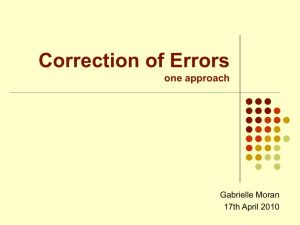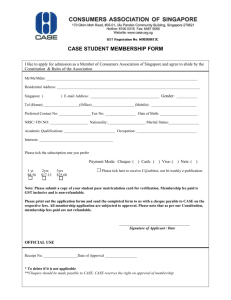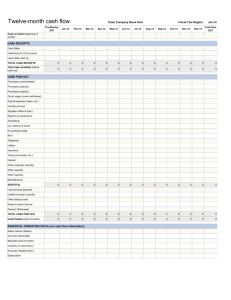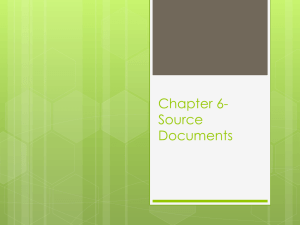Final, First Semester 2014/2015 Time Allowed: TWO hours
advertisement
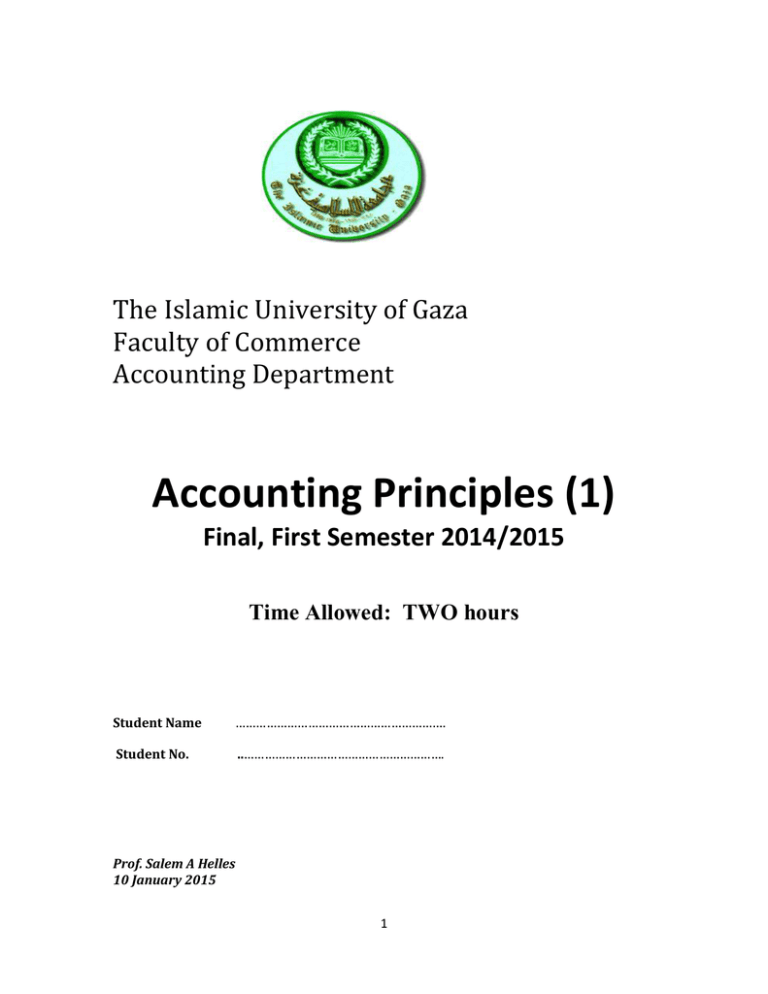
The Islamic University of Gaza Faculty of Commerce Accounting Department Accounting Principles (1) Final, First Semester 2014/2015 Time Allowed: TWO hours Student Name ……………………………………………………. Student No. ..…………………………………………………. Prof. Salem A Helles 10 January 2015 1 Answer Questions One, Two and Require (1) in Question Three on the exam paper: Question One: Choose the correct answer (7 Marks) (1) Which of these best describes non-current assets? (a) Items bought to be used in the business. (b) Items which will not be used quickly. (c) Expensive items bought for the business. (d) Items having a long life and not bought specifically for resale. (2) Which of the following is a liability? a. Cash in hand b. Office equipment c. Accounts payable for goods purchased on credit d. d. Inventory (3) The total of the sales journal is entered on (a) The credit side of the Sales Account is the General Ledger. (b) The credit side of the General Account in the Sales Ledger. (c) The debit side of the sales Account in the General Ledger. (d) The debit side of the Sales Day Book. (4) An alternative name for a Sales Journal is (a) Sales Invoice. (b) Sales Day Book. (c) Daily Sales. (d) Sales Ledger. (5) Entered in the Purchases Journal are (a) Payments to suppliers. (b) Trade discounts. (c) Purchases invoices. (d) Discounts received. (6) Credit notes issued by us will be entered in our (a) Sales Account. (b) Returns Inwards Account. 2 (c) Returns Inwards Journal. (d) Returns outwards Journal. (7) A cash discount is best described as a reduction in the sum to be paid (a) If payment is made within a previously agreed period. (b) If payment is made by cash, not cheque (c) If payment is made either by cash or cheque. (d) If purchases are made for cash, not on credit. (8) Discounts received are (a) Deducted when we receive cash (b) Given by us when we sell goods on credit (c) Deducted by us when we pay our accounts (d) None of these (9) Carriage inwards is always added to the cost of Purchases in the (a) Trading A/C (b) Profit and loss A/C (c) Income statement (d) Purchases A/C (10) Carriage outwards is shown as an expense in the: (a) Trading A/C (b) Profit and loss A/C (c) Income statement (d) Purchases A/C (11) Capital increases by profit and decreases by: (a) Purchase goods (b) Purchase assets (c) Drawings (d) a+b 12. The term “sales” refers to a. Sale of old assets that are no longer needed by the business. 3 b. Sales of goods that were bought for resale. c. Sale of part of the business. d. Cash sales only. 13. The term “purchases” refers to a. Credit purchases only. b. Cash purchases only. c. Goods purchased for resale. d. Purchase of non-current assets for use in the business. 14. Which of the following is not an asset? a. Buildings b. Cash at Bank c. Loan from the Bank d. d. Accounts Receivable Question Two: 7 Marks First Option Company uses special journals ( Cash Day Book, Sales Day Book, Purchases Day Book) and a General Journal. Identify the journal in which each of the following transactions is recorded. (a) Cash sales. (b) Owner withdrawal of cash. (c) Sold goods on account. (d) Receipt of cash for goods sold. (e) Purchase supplies on account. (f) Cash sale of equipment. (g) Credit sales. (h) Purchase of goods on credit. (i) Opening entries (j) Bought fixtures on credit. (k) Paid motor expenses by cheque. (l) A debt owing to us by P. Adel is written off as bad debt. (m) Correction of errors. (n) Purchase of goods by cheque. 4 ____________ ____________ ____________ ____________ ____________ ____________ ____________ ___________ ____________ ____________ _____________ _____________ _____________ ______________ Question Three: 2014 Oct. 1 Oct. 10 Oct. 25 (6 Marks) Sales Sales Sales A. Yousif Account $ 2014 250 Oct. 15 320 Oct. 30 180 Bank Cash $ 200 400 Required: 1- Balance off A. Yousif account at the end of the month . 2- Redraft A. Yousif account in Three – Column Ledger style account. Question Four (20 Marks) You are required to open the books of F. Bader, a trader, via the journal to record the assets and liabilities; then to record the following transactions for the month of May 2014; and Post to Bank Account Only. May, 2014 1 Assets: Premises $30,000; Van $5,000; Fixtures $800; Inventory $6,000; accounts Receivable: B. Muhsen $140; F. Lamia $300; Cash at Bank $6240; Cash in hand $560. Liabilities: Accounts Payable; S. Hani $215; J. Barhoum $640. 2 Paid rent by cheque $400. 3 Goods bought on credit from: S. Hani $145; D. Mabrouk $206. 4 Goods sold on credit to: J. Walid $112; T. Kamal $164. 5 Paid for motor expenses in cash $60. 7 Cash drawings by proprietor $150 for personnel use. 11 Goods returned to us by: J. Walid $32; F. Sami $48. 12 Withdrew $100 from the bank and paid into Cash. 14 Bought another van on credit from Abed Motors Ltd. $5,000. 16 J Walid paid us his account by cheque less 5% cash discount. 19 Goods returned to S. Hani $6; Mabrouk $56. 20 Paid $200 from Cash into Bank. 27 Salaries paid by cheque $740. 30 Purchased office computer from Modern Computers Ltd and paid by cheque $1,400. 31 Paid Abed Motors Ltd their account by cheque less 5% cash discount. 5 Question Five: (4 Marks) Ahmd, a trader, has an inexperienced accountant. During the first 2 weeks on the job, the accountant made the following errors in journalizing transactions. Correct these errors using the short method. 1) A payment on account of $630 to a creditor was paid in cash. It was debited to accounts payable $360 and credited to cash $360. 2) The purchase of equipment on account for $560 was debited to purchases $560 and credited to accounts payable $560. 3) A $400 withdrawal of cash for private use was debited to salaries expense $400 and credited to cash $400. 4) Invested $36,000 cash in the business was debited to cash 63,000 and credited to capital $63,000. Question Six (16 Marks) The following balances were extracted from the books of S. Kamel, a trader, on 31 December, 2014. You are required to prepare Kamel’s Income Statement for the year ended 31 December 2014 and the Statement of Financial Position as at that date. Account Title Inventory 1 Jan, 2014 Purchases Purchases Returns Wages and Salaries Insurance Sundry Expenses Accounts Receivable Furniture and Equipment Cash in hand Capital US$ 52,800 141,300 3,762 63,400 5,500 398 45,900 1,500 276 210,516 Account Title US$ Sales 276,400 Sales Returns 2,800 Delivery Expenses 5,690 Communication Expenses 714 Commissions paid 1,930 Buildings 125,000 Accounts Payable 24,870 Cash at Bank 31,020 Drawings 37,320 Inventory at 31 Dec., 2014 was $58,440 Good Luck 6
